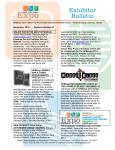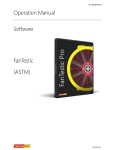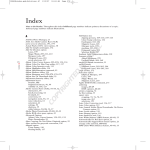Download Wiley Olympus PEN E-PL1 For Dummies
Transcript
Index CO PY RI GH AL RI TE TE D A (aperture-priority autoexposure) exposure mode aperture and shutter speed adjustments, 192 autoexposure settings, locking, 187 for close-ups, 274 defaults, 44 defined, 45, 170 depth of field and, 237 exposure meter, 180 exposure warnings, 180 flash in, 198–209 for landscape capture, 272 for portraits, 263 Reset option and, 41 Accessory port, 9, 10 action capture autofocusing, 270 flash and, 271 manual focusing, 270 S exposure mode, 268–269 Sequential shutter-release mode, 271 shutter speed, 269–270 Adobe Photoshop, 143–144 Adobe Photoshop Elements, 142 Adobe Photoshop Lightroom, 143 Adobe RGB mode, 252–254 AF (autofocus) mode C-AF (continuous autofocus), 48, 85, 99, 215–216 C-AF+TR (continuous autofocus with subject tracking), 48, 99, 216 changing, 44, 215 choosing, 214–217 defined, 214 MF (manual focusing), 216, 230, 231 Movie mode, 99 for movie recording, 214 S-AF (single autofocus), 49, 75, 85, 215 S-AF+MF (single autofocus with manual override), 216 for still photography, 214 AF Area mode All Targets option, 56, 218–219 changing, 44 Face Detection and, 56 settings, 217 Single Target option, 218–219, 222 AF Target button assignment, 305 defined, 75, 214 home position, 219–220 All Targets mode, 218–219 angle of view, 15 Anti-Shock option (Custom Menu E), 48–49 aperture A mode, 192 adjusting, 189–194 defined, 171 depth of field and, 173, 234, 235 in exposure balancing act, 177–178 f-stop numbers, 171 M mode, 193–194 P mode, 191–192 S mode, 192–193 stop down, 173 Apple Aperture, 142 Apple iPhoto, 142 Art filters adding, 292 Diorama, 290, 291 Gentle Sepia, 290 Grainy Film, 290, 291 Pin Hole, 290, 291 Pop Art, 290, 291 Raw files and, 292 Soft Focus, 290, 291 use steps, 292–293 ART mode accessing, 292 Art filters, 290 control screen preferences, 31 defined, 45 exiting, 293 as hybrid mode, 45 MA •A• 320 Olympus PEN E-PL1 For Dummies aspect ratio. See image aspect ratio attaching lenses, 13–14 Audio Video Interleaved (AVI) format, 95 Auto flash mode, 200 Auto White Balance mode, 240–241 autofocusing. See also AF (autofocus) mode for action capture, 270 active focus areas, 217 11-point grid, 217 initiating, 223 for moving subjects, 221, 224–228 options, 214 portrait settings, 265 reset, preventing, 231 setting, matching to subject, 220–221 for stationary subjects, 221, 222–224 techniques, 223–224 zoom-frame, 229–230 automatic camera shutoff adjustment, 106 automatic exposure bracketing (AEB), 209, 273 AVI (Audio Video Interleaved) format, 95 •B• background backlit, 185 blurred, 77, 82, 83, 237 brighter, 85 portrait, softening, 263 Backlit LCD option (Custom Menu D), 39 back-of-the-camera controls, 9–11 banding, 67 Basic (B) compression, 64, 65 battery warning, 316 battery/memory card chamber, 12 Beach & Snow scene mode, 89–90 Beep option (Custom Menu D), 40 bit depth, 67 black-and-white photos, creating from color, 289–290 blown highlights, 122 blurred background adjustment, 77 increasing, 237 portraits, 82, 83 uses, 77 BMP (Windows bitmap), 151 bounce flash, 268 bracketing amount, setting, 210 automatic exposure (AEB), 209, 273 bars, 211 defined, 209 disabling, 211 exposure, 209–211, 212 Exposure Compensation with, 211 flash, 209–211 ISO, 209–211, 212 in landscape capture, 273 picture selection for, 210 series, recording, 211 white balance, 249–252 brightness, 77, 172 brightness histograms axes, 121 defined, 121 highlights, 122 illustrated, 121 interpretation, 122 bulb focusing, 232 burst mode, 47, 85 •C• C-AF (continuous autofocus) with All Targets mode, 226–227 defined, 99, 215 with Micro Four Thirds lenses, 216 with Sport scene mode, 85 steps, 228 using, 227–228 C-AF+TR (continuous autofocus with subject tracking) defined, 99, 216 green target, 226 illustrated, use, 225 with moving subjects, 225–227 with Single Target AF Area, 227 steps for, 225–226 calendar view, 109, 130 Candle scene mode, 88 Center-Weighted Averaging metering, 183 Children scene mode, 86 clipped highlights, 122 Close Up Mode 1, 110–111 Close Up Mode 2, 111–112 Index close-ups capture A exposure mode, 274 depth of field and, 274 fill flash, 274 macro lens/diopters for, 275 Macro mode, 87 settings, 273–275 color cast, 58, 59 color management tools, 161 color modes Adobe RGB, 252–254 setting, 253–254 sRGB, 252, 253–254 color saturation changing, 77 defined, 283 evaluating, 123 increasing/decreasing, 284 tweaking, 283–285 color temperature adjusting, 37 defined, 240 Kelvin scale, 240, 244 colors controlling, 239–252 warm/cool adjustments, 77 compressed air, 70 compression Basic (B), 64, 65 Fine (F), 64, 65 lossy, 64, 66 Normal (N), 64, 65 Super Fine (SF), 64, 65 computer connections operating systems, 145 ports, 146–147 steps, 146–147 transfer process, 147–148 USB cable, 144, 145 USB protocols, 145–146 connection ports, 11–12 continuous autofocus. See C-AF continuous autofocus with subject tracking. See C-AF+TR control screens, 30–32 Control Setting option (Custom Menu D), 39 cropping to aspect ratio, 286–287 defined, 286 JPEG Edit menu options, 287–288 pixel elimination, 288 tools, 158 Custom menu accessing, 23, 37 defined, 21 as gear menu, 22 setup options, 38–41 submenus, 23 Custom Menu A AF Area option, 219 Focus Ring option, 231 MF Assist option, 232 Set Home option, 220 Custom Menu B AEL/AFL Memo option, 307 AEL/AFL option, 306 Function options, 304 Movie button option, 102 My Mode Setup option, 311–312 Custom Menu C, Release options, 216–217 Custom Menu D accessing, 30 Backlit LCD option, 39 Beep option, 40 Control Setting option, 39 in enabling/disabling display modes, 115 EVF Adjust setting, 39 Face Detection option, 55–56, 110 HDMI option, 137 Histogram Setting option, 124 illustrated, 38, 39 Live View Boost option, 38, 196 Mode Guide option, 40 Sleep option, 38 Super Control Panel with, 31 Thumbnail/Info Setting option, 38 USB Mode option, 146, 147 Video Out option, 137, 138 Volume setting, 40 Custom Menu E Anti-Shock option, 48–49 Auto ISO option, 188–189 EV Step option, 186, 210 Exposure/Metering/ISO option, 181, 182 ISO settings selection, 187–188 ISO Step option, 186, 210 Custom Menu F, Flash Compensation and Exposure Compensation option, 208–209 321 322 Olympus PEN E-PL1 For Dummies Custom Menu G Color Space option, 253–254 Noise Filter option, 190 Noise Reduction option, 190 Shading Compensation option, 198 WB option, 247 Custom Menu H DPI Setting option, 315 Edit Filename option, 313 File Name option, 40–41 illustrated, 40 Priority Set option, 314 Quick Erase option, 314 Raw+JPEG Erase option, 130 Custom Menu J Battery Warning option, 316 Exposure Shift option, 185 Pixel Mapping option, 316 Custom Resets option (Shooting Menu 1), 307–310 •D• Date and Time option (Setup menu), 36 default settings limitations of, 43 orientation of, 43 restoring, 41 deleting photos all, 131 one at a time, 130–131 with Raw+JPEG Erase option, 129–130 selected, 131–132 speeding up, 314 depth of field A exposure mode and, 237 aperture as contributor, 173, 234, 235 camera-to-subject distance and, 236 close-ups and, 274 defined, 15, 93, 169, 213, 233 focal length and, 234–236 f-stop relationship, 177, 234, 235 illustrated, 233, 234 large, 233, 234, 237 Live Guide adjustment, 77 manipulating, 233–239 Micro Four Thirds lenses, 238 Portrait mode, 83 preview, 237, 305 shallow (small), 233, 237 tips and tricks, 237 detaching lenses, 14–15 Digital ESP metering, 56, 57, 182–183, 185 diopters, 275 Diorama filter, 290, 291 DIS (digital image stabilization) scene mode, 87 display modes cycling through, 115 enabling/disabling, 115 Highlight and Shadow, 26, 114, 124–125 Histogram, 26, 114, 123–124 Image Only, 114 Light Box, 111, 114, 125–127 Overall, 114, 119–123 Simplified, 107, 114, 116–119 switching between, 24 types of, 114 Displayed Grid display, 26 displays automatic dimming delay setting, 39 customizing, 23–28 exposure modes, switching between, 32 image-only, 27 live, zooming, 27–28 options, 25 scrolling, 28 styles, enabling/disabling, 24–27 distance, depth of field and, 236 Documents scene mode, 88 dots per inch (dpi), 158, 315 downsampling, 159 •E• e-mail, picture preparation for, 163–165 e-Portrait scene mode, 84, 282–283 Erase button, 11 EV Step option (Custom Menu E), 186 EVF Adjust option (Custom Menu D), 39 Export Image dialog box (Olympus [ib]), 150–152 exposure aperture and, 171, 173 backlit backgrounds and, 185 balancing act, 177–178 bracketing, 209–211, 212 Index elements, 170–172 formula, 172 histogram display, 181 ISO and, 172, 174–176 Live Guide and, 81 live preview, 181 locking, adjusting, 306–307 metering modes, 181–186 setting side effects, 172–177 shadow/highlight breaks and, 185 shutter speed and, 171–172, 174 stops measurement, 179 Exposure Compensation autoexposure results adjustments with, 194–196 with bracketing, 211 defined, 180 EV values, 194 Movie mode, 101–102 P (programmed autoexposure) mode, 191 uses, 195 exposure meter in A mode, 180 as Exposure Compensation Guide, 180 in M mode, 179–180 in P mode, 180 in S mode, 180 exposure modes. See also specific exposure modes Auto-flash, 200 control screen, 31 defaults, 44 fill-in flash, 200–202 flash-off, 203 red-eye reduction, 202–203 slow sync with second-curtain sync, 205–206 slow-sync flash, 204–205 types of, 170 Exposure Shift option (Custom Menu J), 185 Express Motions settings (Live Guide), 78 external flashes, 199, 267 •F• Face Detection AF Area mode and, 56 changing, 44 defined, 55 enabling/disabling, 55–56 iAuto mode, 74 metering modes and, 57 SCN mode and, 92 using, 55–57 file format defined, 64 JPEG, 64–66 Raw, 68 File Name option (Custom Menu H), 40–41 file number, 117 file size, 61 filenames personalized, creating, 313 scheme, 116 fill-in flash mode for close-ups, 274 complications, 201–202 defined, 200 uses, 201 Fine (F) compression, 64, 65 Fireworks scene mode, 89 firmware defined, 3, 38 updates, 3, 38 viewfinder features, 20 viewing, 38 first-curtain sync, 205 flash in A mode, 198–209 action capture and, 271 Auto, 83 bounce, 268 bracketing, 209–211, 212 external, 199, 267 Fill mode, 83 iAuto, 75–76 intensity control, 206 in M mode, 198–209 output, adjusting, 206–209 in P mode, 198–209 portraits and, 265–268 raising, 198 in S mode, 198–209 SCN (Scene) mode, 91 Flash Compensation defined, 206 disabling, 209 with Exposure Compensation, 208 functioning of, 207 setting, 207–208 323 324 Olympus PEN E-PL1 For Dummies flash modes Auto, 200 changing, 44, 199–200 defined, 199 fill-in, 200–202 flash-off, 203 manual flash, 206 red-eye reduction, 202–203, 266 slow sync with second-curtain sync, 205–206 slow-sync flash, 203–205, 266 use decision, 200 using, 199–206 Flash Up switch, 9, 10, 198 flash-off mode, 203 Fn/Thumbnails button assigning tasks to, 304–306 depth-of-field preview, 237 functions, 10 illustrated, 9, 107, 304 zooming out with, 111 focal lengths background, 238 defined, 15, 234 depth of field and, 234–236 determining, 16 indicator, 15–16 registration, 53–54 zoom lenses, 16 focal plane marker, 8, 9 focus halfway shutter press, 74 Live Guide and, 81 locking, adjusting, 306–307 manual, 230–232 Movie mode, 99 scene modes, 91 target, 74, 91 understanding, 93 focus point, 120, 223 focus ring, 15, 16, 231 focusing. See also autofocusing basics, 213–232 bulb, 232 on group of moving subjects, 221 manual, 230–232 on moving subjects, 224–228 on solitary subject, 221 on subject in a group, 221 folder names, 116 force flash. See fill-in flash mode formatting, memory cards, 18–19 Four Thirds lenses, 317 frame number, Simplified display mode, 117 frame rate, movies, 96 f-stop defined, 93 depth of field relationship, 177, 234, 235 numbers, 171 as on-screen data, 178 full-frame view, 109 •G• gear menu. See Custom menu Gentle Sepia filter, 290 graduated neutral density, 185 Grainy Film filter, 290, 291 grid display, 26 •H• HDMI (High-Definition Media Interface) port, 11–12 help screens, displaying, 80 high dynamic range (HDR) images, 296 High Key scene mode, 86 Highlight and Shadow display mode defined, 26, 114 exposure adjustment and, 124–125 illustrated, 124, 125 warning threshold, 124 highlights, 122 Histogram display mode as default, 26 defined, 26, 114, 123 in histogram evaluation, 123–124 illustrated, 123 histograms brightness, 121–122 evaluation, 123–124 exposure, 181 RGB, 122–123 hot shoe, 8 Index •I• iAuto mode AF mode, 75 AF Target, 75 Blur Background option, 93 control screen preferences, 31–32 default settings, restoring, 41 defined, 30, 45 Face Detection, 74 flash, 75–76 Image Aspect, 75 Image Quality, 75 Image Stabilizer (IS), 75 ISO setting selection, 188 Live Guide, 30, 76–81 picture setting adjustments, 75–76 picture-taking steps, 74 S-AF mode, 75 shutter-release mode, 75 using, 74–81 icons, this book, 2–3 i-Enhance Picture Mode, 254, 256 image aspect ratio changing, 44, 49–50 crop boundary, 118 crop frame, 119 cropping to, 287–288 4:3, 49, 51 iAuto, 75 in-camera Raw image processing, 155 JPEG setting, 50 with Live Control display, 50, 51 prints and, 157–158 RAW setting, 50 Shooting Menu 1, 50 Simplified display mode, 117 6:6, 49 16:9, 49, 51 Super Control Panel, 50, 51 3:2, 49 Image Only display mode, 114 Image Overlay defined, 294 illustrated, 299, 300 using, 299–300 Image Quality setting changing, 44 customizing, 70–72 for e-mail/online sharing, 164 file format, 57, 64–68 iAuto, 75 in-camera Raw image processing, 155 JPEG, 64–66 Large, 62, 70 list of, 70 Medium, 62, 70 Raw (ORF), 66–68 RAW+JPEG, 68, 70 resolution, 57, 59–64 selecting, 68–69 Simplified display mode, 116–117 Small (S), 63 image sensors, 9, 70 image stabilization changing, 44 dueling system prevention, 54 enabling, 52–53 exposures longer than 2 seconds and, 54 iAuto, 75 lens focal length and, 53–54 Movie mode, 98 overheating and, 54 settings, 52 index view. See thumbnails view indoor portraits, 264, 265 Info button defined, 11 in magnification change, 28, 111–112 in switching display styles, 24 instant review, customizing, 106 ISO bracketing, 209–211, 212 controlling, 187–189 defined, 172 in exposure balancing act, 177–178 image noise and, 174–176 as on-screen data, 178 settings illustration, 176 settings selection, 187–188 shutter speed and, 175 ISO Step option (Custom Menu E), 186 325 326 Olympus PEN E-PL1 For Dummies •J• JPEG advantages/disadvantages, 64 artifacts, 58 compression, 64–65 copy of Raw image, 164 copy of TIFF image, 164–165 editing, 66 Image Quality settings, 70 Large option, 70, 71 low-resolution, 165 Middle option, 70, 71, 72 Olympus [ib] options, 151–152 presets, 70–71 as processed file format, 155 Small option, 70, 71, 72 JPEG Edit menu accessing, 280 Aspect option, 287–288 Black & White option, 289 Crop option, 287 defined, 280 e-Portrait option, 282–283 photo-editing approach, 280–281 Record Annotation option, 301 Redeye Fix option, 281 Saturation option, 283, 284 Sepia option, 289–290 Shadow Adjustment option, 285–286 •K• Kelvin temperature, 240, 244 key tones, 86 •L• landscape capture A exposure mode, 272 bracketing, 273 nighttime city, 273 settings, 271–273 sunrise/sunset, 272–273 tips, 272–273 waterfall/fountain, 272 Landscape scene mode, 81, 84 Landscape+Portrait scene mode, 84–85 Language option (Setup menu), 36 LCD Brightness and Color Temperature option (Setup menu), 37 lenses attaching, 13–14 components illustrated, 15 detaching, 14–15 dirt, 58, 59 discharging, 12 disengaging, 14 focusing ring, 15, 16 Four Thirds, 317 macro, 275 Micro Four Thirds, 13, 238–239, 317 mounting index, 14 Olympus M.Zuiko Digital, 13 OM System, 317 retracting, 16–17 unlocking, 16, 17 working with, 13–17 zoom barrel, 15 lens-release button, 12 Light Box display mode defined, 111, 114, 126 enabling, 126 as hidden, 126 illustrated, 126, 127 tricks, 126–127 viewing photos in, 126 light fall-off, 197 Live Control screen adjusting settings with, 32–34 enabling/disabling, 30 exiting, 34 Face Detection option, 55–56 flash mode setting, 199–200 icons, 33 image aspect ratio access, 50, 51 image stabilization access, 53 learning, 30 lens focal length registration, 53–54 Live View Boost option, 34 metering mode adjustments, 181, 182 option selection, 34 Picture Mode option, 257 SCN mode selection, 92 in selecting Image Quality settings, 68–69 Index settings, 29, 33 shutter-release mode access, 46, 47 White Balance option, 33, 242 Live Guide accessing, 78 adjustments, applying, 78, 79 adjustments, disabling, 80 Blur Background option, 77, 83 Change Brightness option, 77 Change Color Image option, 77 Change Color Saturation option, 77 enabling/disabling, 30 exposure/focus adjustments and, 81 Express Motions option, 78 help screens, 80 Raw format, 81 steps for using, 78–80 live view (LV), 25 Live View Boost option (Custom Menu D), 38, 181, 196 locking exposure, 306–307 focus, 306–307 memory cards, 18 lossy compression, 64, 66 Low Key scene mode, 86 LV (live view), 25 LV-INFO option, 25, 26 •M• M (manual) exposure mode aperture and shutter speed adjustments, 193–194 defaults, 44 defined, 45, 170 exposure meter, 179–180 exposure warnings, 180 flash in, 198–209 Reset option and, 41 macro lenses, 275 Macro scene mode, 87 manual flash, 206 manual focus. See MF (manual focusing) Media Transfer Protocol (MTP), 145 megapixels (MP), 59 memory cards access symbol, 19 formatting, 18–19 handling, 17 inserting, 18 locking, 18 as mechanical devices, 19 Movie mode and, 96 removing, 19 SD (Secure Digital), 17 size, choosing, 19 working with, 17–19 Menu button, 9, 21 menus. See also specific menus displaying, 21 exiting, 23 going back one screen, 22 item selection, 22 item settings, changing, 22–23 list of, 21 selecting, 22 symbols, 21, 22 metering modes. See also exposure adjustment methods, 181–182 Center-Weighted Averaging, 183, 184, 185 checking, 185 defined, 181 Digital ESP, 56, 57, 182–183, 185 exposure decisions based on, 181 Face Detection and, 57 metering-area indicator, 184 Spot, 183, 184, 185 Spot, with Highlight Control, 183 Spot, with Shadow Control, 183 MF (manual focusing) for action capture, 270 automatic magnification, 231–232 bulb focusing, 232 button assignment, 305 defined, 216 focus ring, 48, 231 setting, 230, 231 shooting pace, 48 using, 230–232 Micro Four Thirds lenses. See also lenses defined, 13 depth of field, 238 expanding with use of, 317 35mm film versus, 238–239 use assumption, this book, 13 microphone, 99 midtones, 86 327 328 Olympus PEN E-PL1 For Dummies Mode dial ART option, 292 defined, 8 iAuto option, 74, 78 illustrated, 8 Movie option, 94 SCN option, 82, 90 setting, 32 Mode Guide option (Custom Menu D), 40 monitor adjusting, 37 calibrating, 161 colors, evaluating, 163 colors, synchronizing, 161–163 Monochrome Picture Mode, 255, 256, 288 motion blur, shutter speed and, 174 mounting index, 14 Movie button assigning tasks to, 304–306 customizing, 102 depth-of-field preview, 237 for file protection, 128 functions, 10 illustrated, 9, 94, 304 pressing, 94 in starting/stopping recording, 95 Movie mode A (aperture-priority autoexposure), 100 ART1-ART6, 100–101 autofocusing, 99 defined, 45 Exposure Compensation setting, 101–102 heat safety, 96 image stabilization, 98 M (manual exposure), 100 memory cards and, 96 P (programmed autoexposure), 100 recording quality, 97 recording sound, 98 settings, 45, 96–102 shooting modes, 100–101 movie playback default, 133 fast-forward/rewind, 134 first/last frame jump, 134 frame by frame advance, 134 pausing, 133 in playback mode, 132 sound volume adjustment, 134 starting, 133 movies creating, 93–102 first, shooting, 94–96 format, 95 frame rate, 96 maximum file size, 94–95, 96 one-button recording, 94 in playback mode, 132 recording, starting/stopping, 95, 306 recording data, 133 recording steps, 95–96 recording time, 94 in slide shows, 136 moving subjects with C-AF, 227–228 with C-AF+TR, 225–227 focusing on, 224–228 MP (megapixels), 59 MTP (Media Transfer Protocol), 145 Multi View display mode exposure comparison in, 196 Exposure Compensation and, 27 white balance comparison, 243 Multiple Exposure accessing, 296 defined, 294 illustrated, 298 options, 297 shooting, 298 symbol, 298 using, 296–298 multiple-exposure images, 294–300 Muted Picture Mode, 255, 256 My Mode feature defined, 310 presets, 311, 312 settings registration, 311 Setup screen, 312 storing camera settings with, 311–312 uses, 310–311 •N• Natural Picture Mode, 255, 256, 259 Nature scene mode, 87 Night Scene mode, 85 Index Night+Portrait scene mode, 86 noise appearance of, 174 dampening, 190 defined, 58, 190 illustrated, 58 ISO and, 174–176 Noise Filter feature, 176, 190 Noise Reduction feature, 176, 190 Normal (N) compression, 64, 65 •O• Olympus [ib]. See also photo software Art Filter icon, 150 Basic Settings palette, 150 defined, 140 Distortion icon, 150 Export Image dialog box, 150–152 Raw Development window, 149 Raw image processing in, 149–153 Olympus M.Zuiko Digital lens, 13 Olympus Master 2 defined, 141 Email feature, 165 file format, 154 Raw image processing in, 153–154 Resize and Convert Format feature, 165 Resolution value, 154 storage location, 153 Olympus Web site, 3 OM System lenses, 317 One Touch White Balance feature. See also White Balance settings button assignment, 305 defined, 241, 244 steps, 245–246 using, 244, 245–246 ORF (Olympus Raw Format). See Raw organization, this book, 1–2 Overall display mode aspect ratio crop frame, 119 blinking red/blue pixels, 119 defined, 114, 119 exposure and focal length settings, 120 file data, 120 focus point, 120 illustrated, 119, 120, 121 Picture Mode settings, 120 •P• P (programmed autoexposure) exposure mode aperture and shutter speed adjustments, 191–192 autoexposure settings, locking, 187 defaults, 44 defined, 45, 170 Exposure Compensation setting, 191 exposure meter, 180 exposure warnings, 180 flash in, 198–209 Reset option and, 41 Panorama scene mode, 88–89 photo paper, 161 photo software Adobe Photoshop, 143–144 Adobe Photoshop Elements, 142 Adobe Photoshop Lightroom, 143 Apple Aperture, 142 Apple iPhoto, 142 color management issues, 162 Olympus [ib], 140, 149–152 Olympus Master 2, 141, 153–154 selecting, 139–144 Windows Photo Gallery, 142 photography settings all-purpose, 262 camera buttons, 30 Live Control screen, 29 menus, 29 recap, 261–263 Super Control Panel, 29 Picture Modes changing, 44 Custom, 258–259 defined, 254 i-Enhance, 254, 256 illustrated, 256 in-camera Raw image processing, 155 modifying, 257–258 Monochrome, 255, 256, 288 Muted, 255, 256 Natural, 255, 256, 259 Overall display mode, 120 Portrait, 255, 256 Vivid, 255, 256 329 330 Olympus PEN E-PL1 For Dummies pictures comparing, 126–127 data, viewing, 114–127 deleting, 129–132 for e-mail/online sharing, 163–165 filenames, 116 magnifying, 109–112 multiple, viewing, 108–109 multiple-exposure, 294–300 protecting, 128–129 quality. See Image Quality setting rotating, 112–114 scrolling through, 107 selecting, 109 sending to computer, 144–148 testing, 305 viewing in calendar view, 109 viewing in Playback mode, 107–114 voice annotation, 301–302 Pin Hole filter, 290, 291 Pixel Mapping utility, 316 pixelation, 58 pixels adding, 159, 160 blinking red/blue, 119 count, 61, 72 cropping and, 288 defined, 59 dimensions, 59 faulty, checking for, 315–316 playback movie, 132–134 photos on television, 137–138 slide show, 136 timing, customizing, 106–107 voice annotation, 302 Playback button, 10, 107 Playback menu functions, 21 Print Reservation option, 117 Slide Show option, 135–136 playback mode calendar view, 109, 130 deleting photos in, 129–132 Fn/Thumbnails button, 10 Movie/Protect button, 10 picture data viewing, 114–127 picture viewing, 107–114 pictures on television viewing, 137–138 playing movies in, 132–134 protecting photos in, 128–129 single-frame view, 109, 128, 130 slide shows, 135–136 thumbnails view, 108–109, 129, 130–132 Pop Art filter, 290, 291 Portrait Picture Mode, 255, 256 Portrait scene mode, 81, 83 portraits A exposure mode, 263 autofocus settings, 265 background, softening, 263 blurred background, 82, 83 flash and, 265–268 hot spots, 266 indoor, 264, 265 outdoor, 83, 264–265 shooting, 263–268 slow-sync flash with, 204 subject positioning, 267 posterization, 67 Power button, 8 presets defined, 308 JPEG, 70–72 modifying, 309 for picture settings, 307–310 setting up, 308 using, 309–310 print aspect ratio, 157–158 colors, 161–163 photo paper, 162 planning for, 156–163 proportions, 156–158 resolution, 62, 158–160, 315 size, pixel count and, 61 printers, 161–162 protect status defined, 128 memory formatting and, 128 rotating photos and, 113 Simplified display mode, 118 protecting files defined, 128 in single-image view, 128 in thumbnails view, 129 unlocking and, 129 Index •R• Raw (ORF) advantages, 66–67 Art filters and, 292 bit depth, 67 creative control, 67 defined, 66 disadvantages, 67–68 file processing, 148–156 file size, 68 JPEG copy, 164 Live Guide and, 81 picture quality, 67 raw converters, 67, 148 Raw Data Edit feature, 154, 157 Raw image processing in camera, 154–156 in Olympus [ib], 149–153 in Olympus Master 2, 153–154 raw converter, 67, 148 RAW setting, 68 RAW+JPEG setting, 68, 305 Rec View option (Setup menu), 37, 106 red-eye defined, 202 removal tools, 282 repair, 281 Redeye Fix filter, 281 red-eye reduction. See also flash modes with P and A modes, 202, 203 with portraits, 266 with S and M modes, 202, 203 slow-sync flash with, 205 using, 202–203 release-priority options, 216 resampling, 159 resolution defined, 59 Large setting, 62, 70, 71 Medium setting, 62, 70, 71, 72 minimum for print, 158 pixel count and, 61 print, 62, 158–160, 315 settings, 60, 158 shooting speed and, 63 Small setting, 63, 70, 71, 72 RGB histograms, 122–123 RGB images, 123 rotating photos direction, 114 as in-camera edits, 112–113 Protect option and, 113 steps, 113–114 •S• S (shutter-priority autoexposure) exposure mode for action capture, 268–269 aperture and shutter speed adjustments, 192–193 autoexposure settings, locking, 187 defaults, 44 defined, 45, 170 exposure meter, 180 exposure warnings, 180 flash in, 198–209 Reset option and, 41 S-AF (single autofocus) defined, 215 iAuto mode, 75 shutter release and, 49 for stationary subjects, 221, 222–224 S-AF+MF (single autofocus with manual override) defined, 216 as S-AF mode alternative, 224 using, 223–224 saturation. See color saturation Saturation filter, 283–284 scene modes Beach & Snow, 89–90 Candle, 88 Children, 86 defined, 81 descriptions, 90 DIS, 87 Documents, 88 e-Portrait, 84 Fireworks, 89 flash, 9 focus, 91 High Key, 86 Landscape, 81, 84 Landscape+Portrait, 84–85 331 332 Olympus PEN E-PL1 For Dummies scene modes (continued) Low Key, 86 Macro, 87 Nature, 87 Night Scene, 85 Night+Portrait, 86 Panorama, 88–89 Portrait, 81, 83 selecting, 90 Sport, 82, 85 Sunset, 88 SCN (Scene) mode accessing, 82 benefits, 82 control screen preferences, 31 default settings, restoring, 41 defined, 45 experimentation, 82–83 Face Detection and, 92 Live Control display and, 92 picture settings, 92 results, 82 Super Control Panel and, 92 taking pictures in, 90–92 tips, 92 using, 81–93 SCP. See Super Control Panel SD (Secure Digital) cards, 17 second-curtain sync, 205 Secure Digital (SD) cards, 17 Sequential mode, 47, 85, 271 Setup menu Custom Menu Display option, 37 Date and Time option, 36 Firmware option, 38 functions, 21 Language option, 36 LCD Brightness and Color Temperature option, 37 options, 36–38 Rec View option, 37, 106 as wrench menu, 22 Shading Compensation, 197–198 Shadow Adjustment filter, 285–286 shadows bringing subjects out of, 285–286 highlight breaks, 185 Spot metering and, 183 sharpening, 254 Shooting Menu 1 Card Setup option, 131 Custom Reset option, 41, 307–310 functions, 21 options, 29 in selecting Image Quality settings, 68 Shooting Menu 2 Bracketing option, 209, 211, 251 functions, 21 image aspect ratio access, 50 image stabilization access, 52 lens focal length registration, 54 Multiple Exposure option, 296–297 options, 29 Picture Mode option, 257 shutter-release mode access, 46, 47 shooting speed, resolution and, 63 Shooting Tips icon, 80 Shutter button configuration, 8 illustrated, 8 M mode, 193–194 S mode, 192–193 shutter speed A mode, 192 for action capture, 269–270 adjusting, 189–194 blurry photos and, 228 defined, 93, 171–172 in exposure balancing act, 177–178 ISO and, 175 motion blur and, 174 as on-screen data, 178–179 P mode, 191–192 slow, 174 shutter-release mode changing, 44 with down-arrow key, 46 iAuto, 75 with Live Control display, 46, 47 Sequential mode, 47–48 setting, 46–47 with Shooting Menu 2, 46, 47 single frame mode, 47 with Super Control panel, 46, 47 12-Second Self-Timer, 48 2-Second Self-Timer, 48 Index Simplified display mode aspect border, 118 aspect ratio, 117 date and time, 116 as default, 107 defined, 114 DPOF print status, 117–118 file number, 117 frame number, 117 Image Quality setting, 116–117 protect status, 118 sound annotation, 118 single autofocus. See S-AF single autofocus with manual override. See S-AF+MF single frame mode, 47 Single Target mode defined, 218 focus area, 218 for stationary subjects, 221, 222–224 switching from/to, 218, 219 single-image view, 128, 130 Sleep option (Custom Menu D), 38 Slide Show feature, 135–136 slide shows (in-camera), 135–136 slow sync with second-curtain sync mode, 205–206 slow-sync flash. See also flash modes defined, 203 exposure modes and, 204–205 illustrated use, 203–204 with portraits, 204, 266 with red-eye reduction, 205 Soft Focus filter, 290, 291 software. See photo software sound movie playback, 134 movie recording, 98 slide show playback, 136 speakers, 11, 40 Sport scene mode, 82, 85 Spot metering, 183, 184, 185 Spot metering with Highlight Control, 183 Spot metering with Shadow Control, 183 sRGB color mode, 252, 253–254 Start/OK button and arrow pad, 9, 11 Storage, 145 Sunset scene mode, 88 Super Control Panel (SCP) Color Space setting, 253–254 defined, 29, 34 enabling/disabling, 30, 31, 34 exiting, 35 Face Detection option, 55–56 flash mode setting, 199–200 image access ratio access, 50, 51 image stabilization, 53 learning, 30 metering mode adjustments, 181, 182 options, selecting, 35 Picture Mode option, 257 reason to use, 34 SCN mode selection, 92 in selecting Image Quality settings, 68–69 shutter-release mode access, 46, 47 using, 29, 34–35 White Balance setting, 35, 242 Super Fine (SF) compression, 64, 65 symbols, menu, 21, 22 •T• Tagged Image File Format. See TIFF format through-the-lens (TTL) metering, 206 Thumbnail/Info Setting option (Custom Menu D), 38 thumbnails view default, 131 defined, 108 deleting images one at a time, 130 deleting selected images in, 131–132 illustrated, 108 protecting files in, 129 selected images, 132 thumbnail display, 108–109 using, 108–109 TIFF (Tagged Image File Format) format defined, 151 files, 66 JPEG copy, 164–165 Olympus [ib] options, 151–152 topside controls, 8–9 transfer, camera-to-computer, 147–148 tripod mount, 12 12-Second Self-Timer, 48 2-Second Self-Timer, 48 333 334 Olympus PEN E-PL1 For Dummies •U• underwater shooting modes, 305 unlock switch, lens, 15, 16 unlocking lenses, 17 upsampling, 159 USB cable, 144, 145 USB protocols, 145–146 USB/AV port, 11–12 •V• VF-2 electronic viewfinder, 20, 39 vignetting, 197–198 Vivid Picture Mode, 255, 256 voice annotations, 301–302 Volume option (Custom Menu D), 40 •W• White Balance Compensation, 248 White Balance settings adjustment tips, 243–245 Auto mode, 240–241 changing, 44, 241–245 color cast problems and, 59 color correction with, 239–241 fine-tuning, 244, 246–249 in-camera Raw image processing, 155 Live Control display, 33 One Touch White Balance, 241, 244, 245–246 previewing, 243 selecting, 247 settings illustration, 242–243 Super Control Panel, 35 white balancing, 240 white-balance bracketing amount and type specification, 251 applying, 251–252 defined, 249 disabling, 252 illustrated, 250 series, 249 shooting mode requirement, 249 Windows Photo Gallery, 142 wrench menu. See Setup menu •Z• zoom barrel, lens, 15 Zoom button in Close Up Mode 1, 110 in Close Up Mode 2, 111, 112 function, 10 illustrated, 9, 107 for live preview, 27–28 for zoom-frame autofocus, 229–230 zoom lenses, 16 zoom-frame autofocus, 229–230 zooming, 27–28, 109–112

























